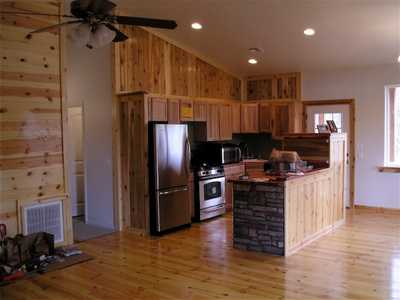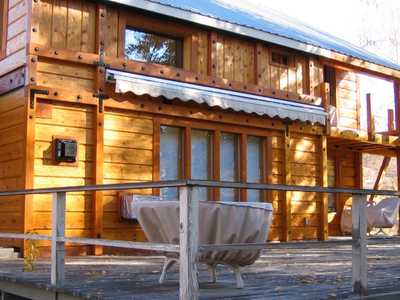
Ponderosa Pine
Ponderosa Pine (PP) is one of North America’s most abundant species. It is often milled and sold in combination with other similar Western Pine species (Sugar Pine, Lodgepole Pine, White Pine’s, Engelmann Spruce and other western white softwoods). PP is contains less pitch that Eastern Long Leaf Pine’s or Southern Yellow Pine.
PP has little heart wood and is mainly sapwood, although in lower grades the heartwood becomes more common. This species of lumber is often used for interior and exterior applications. Such as paneling, trim, flooring, doors, windows, fascia, soffits and many more.
Scientific Name: Pinus Ponderosa
Lumber Sizing
If you need a particular net size of material, please be sure to make your sales representative aware of the exact net size so he can provide you with the right piece of lumber.
Ponderosa Pine Grading & Quality Control
Lumber Grading Rules assure users of Ponderosa Pine and other softwoods consistent standards of quality, regardless of which mill produces the lumber.
Appearance Grades – Ponderosa Pine Boards are graded primarily on appearance for a multitude of applications. There are three grades of Selects and five grades of Commons (WWPA Rules) and there are also Alternate Board grades available (West Coast Lumber Inspection Bureau Rules).
Note: all pictures are meant for a general grade description. If you want to see a more defined grade image, please let us know. We can email you pictures and grade rules.
Available Pine Grades



- c – C & Better Clear – This grade is for the most part blemish-free. In demand for quality interior finishing material and for cabinet work.
- 2 – #2 Common – Intended for use in housing for paneling, shelving, siding, soffits and fascia.
- 3 – #3 Common – Used for shelving, paneling, fences, and siding.
Availabe Spruce Grades


- 2s – #2 Common Spruce – Same rules apply as for Pine #2 Common.
- 3s – #3 Common Spruce – Same rules apply as for Pine #3 Common.
Ponderosa Pine / Spruce In Application Photo Album
Browse our line of products below, or browse by species on the lumber species page. We aslo have a Raw Lumber Picture Gallery. If you don’t see what you are looking for don’t hesitate to email us and request a custom job.

Interior Paneling
Pine doesn't just look fantastic on walls as interior paneling, it's easy to install and also acts as a sound absorber. The natural softness of the wood creates an insulator that quiets down any room more than harder woods ever could.
This species of wood paneling can add charm, interest, and warmth to any room. It can also make you feel calmer and more at home. We offer most common patterns in-stock, and we have the capability to mill almost any pattern you can think of to get the perfect look.
Ceiling Paneling
Pine is one of the best options for ceilings, loft decking, or roof decking for many styles and sizes of homes. It has advantages over hardwoods like easy to work, sustainable, comes with a tongue and groove design, and is very affordable.
Our inventory includes all sizes and patterns in Pine ceiling products, and we offer additional special order patterns.
Flooring
Pine flooring is highly durable and around the country,. In fact, pine floors of 100 years old or even older are still in use today. A pine floor will serve you well for the full life of your home, unlike a temporary floor covering such as linoleum. This species of softwood lumber offers a complete different look, Pine flooring and blue stained pine have light tones and beautiful character.

Siding
Pine has long been a standard for exterior siding. It is durable, weather resistant, relatively quick and easy to install, has a great natural look and is an inexpensive to all other siding products.
Blue Stain Pine

Add a touch of color to the charm
Nothing else says country living like pine paneling does. Add the natural stains of Blue stained pine, and you have character and color in the same product.
Pine paneling is one of the most inexpensive yet beautiful ways to add a special touch to a room, be it on the ceiling or on the walls. If you want the extra touch of character look at our Blue Stained pine patternsAs with other pines, Ponderosa can be subject to blue stain if a felled tree or green lumber becomes too warm before it is dried. Blue stain does not affect strength and is admissible in some of the lower grades. It can be hidden with paint or enhanced with clear finishes depending on user preference. This is also caused by bug holes, rot and/or disease. Basically something that affected the tree’s fibers.
Raw Lumber Product Chart
| Post and Beams | Surfaced Four Sides S4S |
|---|---|
| Rough Cut | |
| Free of Heart Center (F.O.H.C.) | |
| Boards | |
| Surfaced One Side and Two Edges (S1S2E) | |
| Surfaced For Sides (S4S) | |
| Rough Cut | |
| Paneling & Patterns | |
| Tongue and groove | |
| Double Flush | |
| Channel | |
| Beaded | |
| Roofing & Exterior | |
| Shakes and Shingles | |
| Siding | |
| Decking | |
| Soffit |
Characteristics Of Pine
Stability: All woods shrink and swell to some degree as their moisture content fluctuates with atmospheric conditions.
However, Ponderosa is relatively unaffected by changes in humidity after drying, making it valuable for work that requires close-fitting joints. It has a uniform cell structure and shrinks only a moderate amount, in comparison to other softwood species. It seasons beautifully with minimal splitting, cupping or warping.
Workability: Easy to cut, saw, nail and glue
Seasoning: All Ponderosa Pine is dried before surfacing to assure uniformity of the finished size. It is seasoned in temperature and humidity-controlled dry kilns or stacked and air-dried until the moisture content reaches the desired level–from 12 to 19 percent.
Link to more technical information regarding Ponderosa Pine…
Available Patterns
Tongue & Groove, Lap Patterns, Pattern 105 , Edge & Center Bead , S4S
Characteristics and best uses:
Ponderosa Pine has a minimal amount of of reddish-brown heartwood and exceptionally wide sapwood which is honey-toned or straw-like in color.
It has a straight, uniform grain which machines to a clear smooth surface. When freshly sawn or surfaced, its pleasant smell is reminiscent of the forests where it grows. Ponderosa Pine is often specified when appearance rather than strength is of primary importance.
Ponderosa Pine is relatively unaffected by changes in humidity after drying, making it valuable for work that requires close-fitting joints. It has a uniform cell structure and shrinks only a moderate amount, in comparison to other softwood species. It seasons beautifully with minimal splitting, cupping or warping.
More Information about Ponderosa Pine
Ponderosa Pine covers approximately 27 million acres of land. Stands can be found from Canada to Mexico and from the Pacific Coast eastward to the Black Hills of South Dakota.
Its growth range covers an area encompassing more than 35 percent of the total acreage of the U.S. Oregon, Washington and California account for a major share of the annual harvest. Arizona and South Dakota are also important producing areas with lesser amounts coming from Idaho, Wyoming, Montana, Utah and New Mexico.
Ponderosa Pine trees average 100’ to 160’ in height, with some exceeding 180’. The trees range from 2-4’ in diameter, with the rate of growth depending upon altitude, soil, temperature and rainfall. Mature Ponderosas can be easily identified by their distinctive orange-brown bark which is arranged in large plates. The dark yellow-green needles are 5-10” long and grow in clusters of three.
The cones, similar in color to the bark, are 3-6” long and 2-4” in diameter. Seeds are 5/16-3/8” long with a 3/4-1” wing. In pure, or nearly pure, stands of Ponderosa Pine there is a standing inventory of approximately 188 billion board feet of lumber; in mixed stands there are additional billions of board feet in unmeasured inventory. Most Ponderosa trees grow, mature and survive for about 125 years before they are lost to natural causes such as rot, insect damage, fires or wind throw. Occasionally, a lone specimen will survive for nearly 200 years.
Their typical site is on semi-arid plateaus and slopes, often surrounded by Juniper and Sage. Ponderosa Pine forests are usually selectively harvested rather than clear cut. This method of logging removes only the overmature trees, and leaves the other trees to re-seed and mature.
Selective harvesting often makes it difficult to identify a recently logged stand. The Western pines are distinct from the Southern Yellow pines which are denser and pitchier, with widely different characteristics and uses.
Production
The annual production of Ponderosa Pine ranks third in volume after Douglas Fir and Hem-Fir, but second in total value.
Oregon is the nation’s leading supplier ofPonderosa Pine, producing approximately 1.3 billion board feet annually. California is second with slightly more than one billion board feet. U.S. softwood lumber exports are led by Douglas Fir and Hem-Fir, with Ponderosa Pine in third place.
Canada is the largest importer of Ponderosa Pine, with Mexico and japan as distant runners-up. The applications for Ponderosa Pine in Canada and abroad are very similar to those in the United States.




